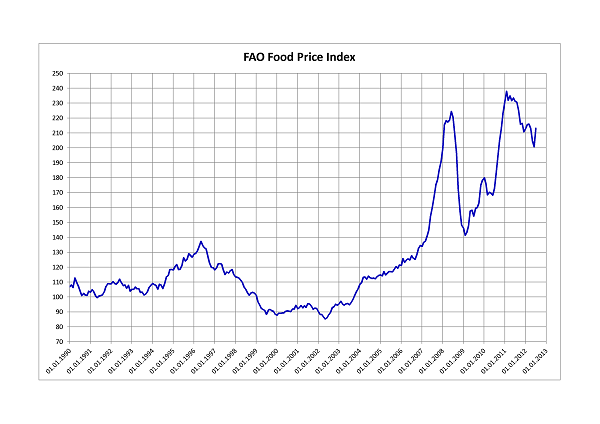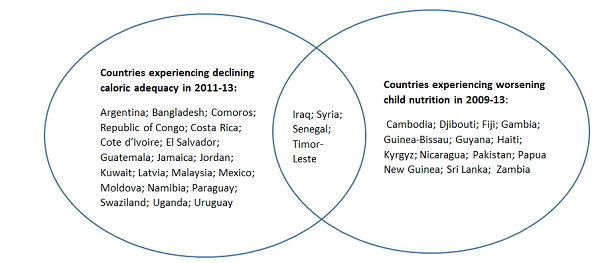Twice in the past decade, food prices have spiked: first in in 2007-8, and then 2010-11. And food prices on average have been much higher in the last seven years than in the previous 15. In Figure 1, you can see these spikes in food prices, and you can also see where the move toward higher average prices begins when the line first rises above 140 shortly after 2007.
This recent behavior of food prices has led to concern about potentially adverse impacts on child nutrition. The 2012 Global Monitoring Report noted that “even temporarily high food prices affect the long-run development of children,” especially among the poor, in part through malnutrition. So is there reason to be alarmed?
Figure 1. FAO food price index, 1990-2013

One channel through which food price spikes affect child nutrition is food or caloric adequacy. Food price spikes can make food unaffordable to poor people and this in turn has an impact on their children’s nutrition. If this chain of transmission were critical, one would expect a high correlation between changes in food or caloric intake and child nutrition.
This hypothesis can be tested in a preliminary fashion from recent data on caloric security and child nutrition trends provided in the Global Hunger Index (GHI) database of the International Food Policy Research Institute (IFPRI). Caloric security can be proxied through a measure of the proportion of the population whose food intake is insufficient to meet minimum dietary energy requirements. This is reported as the “proportion of undernourished” in the GHI database. The 2014 database allows us to compare caloric adequacy for the pre-spike years as an average over 2004-06 and the post-spike years as an average for 2011-13.
The data show that 24 out of 140 countries experienced an increase in the proportion of undernourished in the years following the food price spikes (see Figure 2). In six of these countries, the proportion of undernourished was very low to begin with (under 5 percent of the population) and stayed low despite the uptick. However, for other countries, both the initial level of undernourishment and the increment were rather striking. For Moldova, the proportion rose from 16.6 to 28.2; for Paraguay from 12.6 to 22.3; for Swaziland from 16.7 to 35.8; and for Timor-Leste from 27.6 to 38.3.
Now consider what has been happening to child nutrition. Data on child nutrition (measured as the proportion of underweight children under 5 years of age) are available from the same IFPRI database. Comparing across the pre-spike years (averaged for 2003-07) and the post-spike years (averaged for 2009-13) shows 17 countries experiencing an increase in the prevalence of underweight children.
Figure 2. Countries with declining caloric intake, worsening child nutrition, or both

But the majority of the countries where child nutrition worsened are not countries where caloric adequacy declined. Only four countries experienced both reduced caloric sufficiency and worsened child nutrition: Iraq, Senegal, Syria and Timor-Leste. This suggests that changes in food availability were not a major reason for changes in child nutrition in recent years.
This finding makes sense once one thinks through the implied links between food price increases, caloric adequacy and child nutrition at the country level. Regarding the first link, food price increases are assumed to make it more difficult for poor countries to import food, thereby leading to reduced availability. But this assumption may be misleading. Many low-income countries are also food producers and an increase in global food prices could well lead to increased total domestic supply even if some of the incremental supply ends up being exported.
At the same time, child nutrition is affected not just by access to food but also by such factors as health care, sanitation, mother’s education, and so on. It is also possible that these other factors play a larger role than food intake in determining child nutrition outcomes, something that can only be checked through proper econometric analysis.
Given these possibilities, it is not surprising that our preliminary look at the data fails to show an effect flowing from recent food price spikes to child nutrition outcomes through the food availability channel.
The Brookings Institution is committed to quality, independence, and impact.
We are supported by a diverse array of funders. In line with our values and policies, each Brookings publication represents the sole views of its author(s).




Commentary
Did recent food price spikes compromise child nutrition?
June 4, 2015